As a homeowner, it can be difficult to plan for home upgrade expenses. When any of your home appliances or HVAC, plumbing, and electrical systems break down, it’s important to understand how you can fund and finance repairs and upgrades to work with your budget.
What Upgrades are a Priority?
When upgrading your home, whether you want to replace the carpet with hardwood flooring or upgrade your furnace to a more energy-efficient model, it’s essential to prioritize your home upgrades accordingly. While hardwood flooring would be wonderful, if your furnace is nearing its average lifespan, it’s more of a priority to set aside funds for that upgrade rather than new flooring. One way to try to achieve both goals, however, is to have separate accounts — one for saving for home upgrades and the other for home repairs.
Overall, you’ll want to prioritize the home repairs and upgrades related to your home’s structure or integrity, like the following features:
- Roof
- Gutters
- Foundation
- Electrical wiring
- Heating and cooling system
- Plumbing
- Windows
If your home’s structural features are secure, consider upgrading your appliances. If your home’s appliances are intact and energy-efficient, unlike an old dryer or washer, you can feel more secure saving for future home upgrades. However, be sure to continue setting aside savings for future surprise home repairs.
What Home Improvements are Tax Deductible?
Everyone loves a tax deduction, which is why many new homeowners are curious about what home improvements are tax deductible. Deductions for improvements to your home vary. Please check with your tax professional for full details and direction on the below opportunities.
You can earn a general home tax deduction, as well as tax benefit, through three methods:
1. Selling your home.
If you live in your home for two to five years, and you may qualify for this tax benefit. This benefit, also known as the home sale tax exclusion, prevents the taxation of part of the money from the sale of your home.
How it works is the first $250,000 of profit from your home is tax-free, if you’re the sole owner. If you own it with your spouse, that amount rises to $500,000, but you must file your taxes together.
So, say you sold your home for $350,000 and purchased it for $200,000. During your ownership, you invested $75,000 into home improvements. Combine your investments with your purchase price for a total of $275,000, and subtract it from the sale price — the difference is $75,000. Because $75,000 is less than $250,000 or $500,000, it’s tax-exempt.
While this benefit does not qualify as a tax deduction, it is helpful when selling your home and rewards you for investing into your property.
2. Maintaining a home office.
A home office is a yearly tax deduction. To qualify, you need to operate a business and use a portion of your home regularly as an office for your business. You can deduct home upgrade expenses for remodeling a room for your office, plus any improvements to your home.
Improvements depreciate based on how much of your home you commit to an office. If your office takes up 10 percent of your home, then you’ll depreciate 10 percent of the cost of upgrading your toilet or electric wiring, even if these upgrades are outside of your home office.
3. Renting your home.
The expenses you cover for renting rooms in your home are tax deductible. For example, if you replace the carpeting in a tenant’s room or repair their window, it’s a tax-deductible home improvement. Similar to maintaining a home office, you would divide other home expenses like utilities, insurance, and trash removal into similar percentages. For instance, if you rent out 30 percent of your home, you would deduct 30 percent of your expenses (like utilities) that you and renters share. You can also divide your home by the number of rooms in your house, so long as they’re similar sizes. So, if your house has six rooms and you rent two, then you can deduct around 30 percent of your expenses.
For most homeowners, only the home sale tax exclusion is a viable tax deduction. Depending on where your home upgrade expenses are going, though, you may be able to receive a tax credit. The following home items offer tax credits:
- Metal or asphalt roof
- HVAC unit
- Insulation
- Water heaters
- Doors
- Windows
It’s important to note that these products must be energy- or heat-efficient to qualify for a tax credit. Check before making a purchase that the item you’re interested in qualifies for the tax credit. If it doesn’t, ask about similar items that do have a tax credit.
How to Pay for Home Upgrades
Saving for home upgrades is difficult if you’re also paying off loans, a mortgage and everyday expenses. When a surprise home repair arises, many homeowners ask about financing options to work within their budget.
How you pay for a home upgrade depends on your provider. Some installers for a new HVAC system, for example, may not offer payment plans or have plans with high-interest rates, which is why it’s important to maintain a home upgrade expense fund, if possible. Some financing options, however, are useful even if you have the money available due to their lower interest rates and monthly payments.
Handle Home Upgrade Expenses With Ease in PA
Whether you’re upgrading or repairing your home, it’s important to think about how you’ll finance and fund planned and unplanned home expenses. At Haller Enterprises, we offer a variety of premium services like electrical, plumbing and heating and cooling, as well as two flexible financing options that provide you with revolving credit and monthly payments that meet your budget.
Learn more about our services and financing options by contacting us today for more information.
Also – feel free to check out previous installments of our “Homeowner Series” below:




